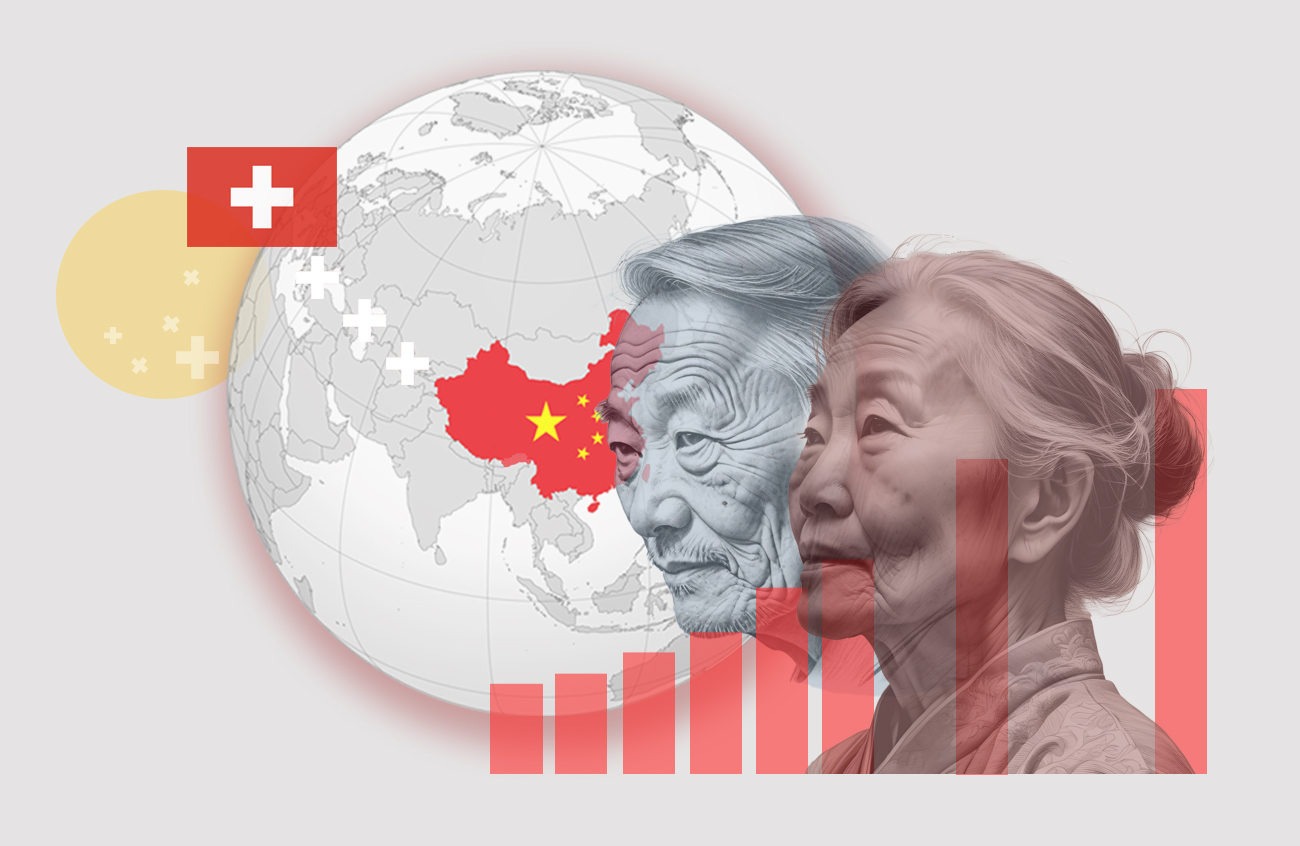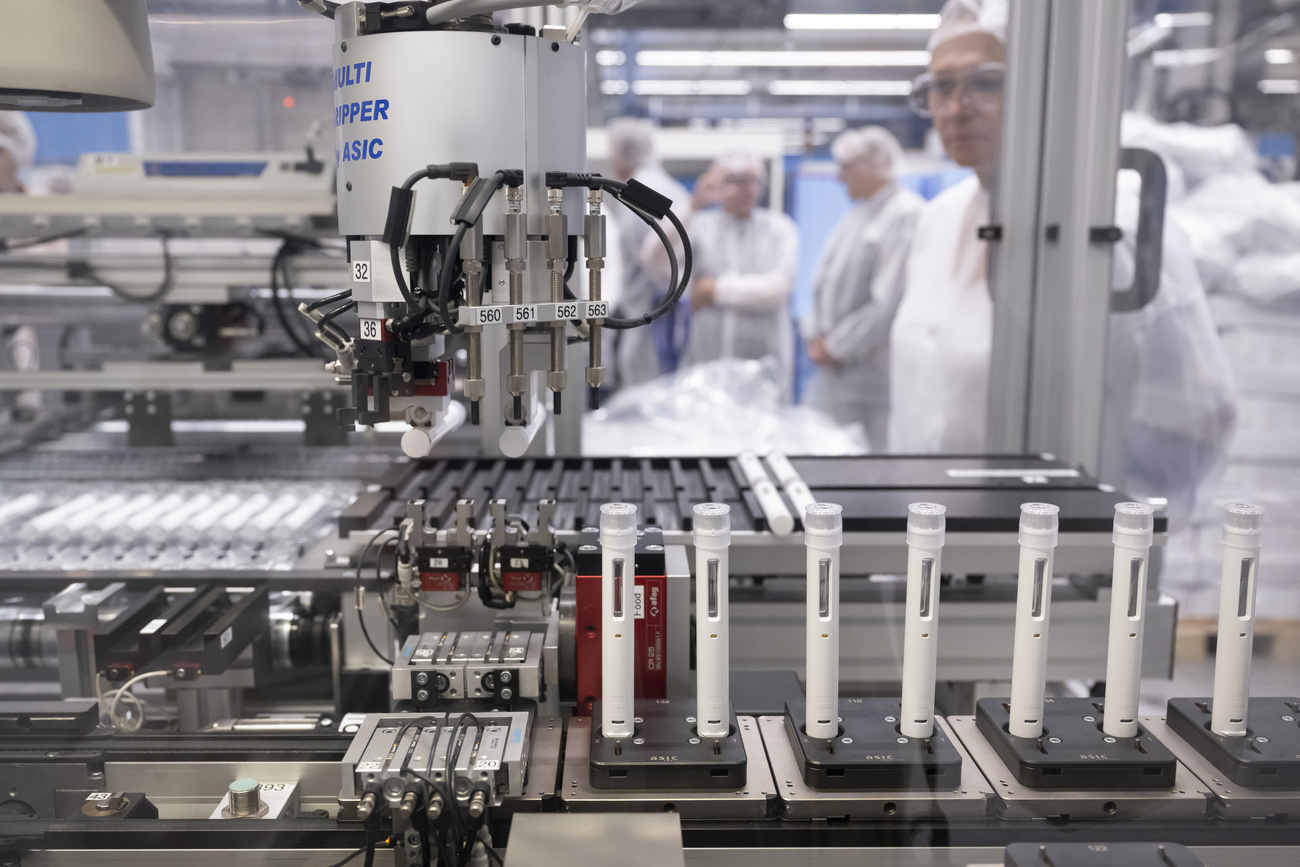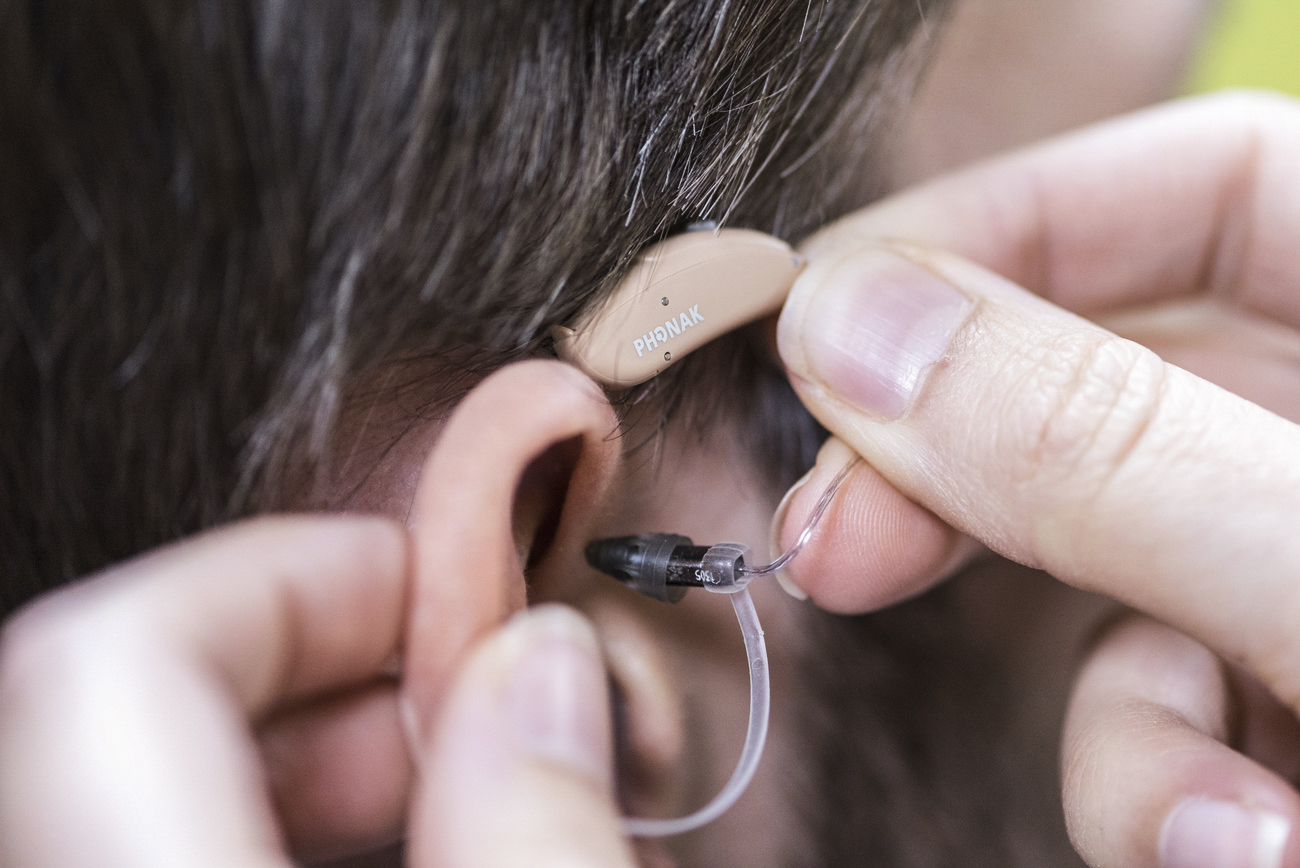Swiss multinationals see gold in China’s silver economy

China’s rapidly ageing population and a growing middle class are opening up new opportunities for two Swiss medical companies who are targeting the country as their next growth market.
Many countries around the world are facing the challenge of an ageing population, but none more so than China. By 2035 around a third of its citizens, some 400 million people, will be aged 60 and over, according to estimates published by the country’s National Health Commission (NHC), an increase of 100 million over a span of just 13 years and almost equivalent to the entire population of the European Union.
The greying society and the accompanying health challenges are attracting some of the world’s top healthcare companies who see solid growth opportunities in a rapidly expanding market. They include Switzerland-based Sonova, the world’s biggest hearing aid maker, and medical technology group Ypsomed, which specialises in making insulin pumps for diabetics.
“The ultimate reason for China’s strategic importance is the increasing ageing population,” says Fang Fang, a healthcare industry veteran and general manager of Sonova in China. “Every year, we have half the total population of France or Germany turning into our potential customer pool.”
The McKinsey Health Institute forecasts that the number of people aged 65 and over in Asia will double to 1.6 billion by 2050, describing the increase as “one of the most profound demographic shifts in history.” The trend is most pronounced in China where the ageing population is growing faster than any of the world’s other emerging economies.
The increase in life expectancy is contributing to the challenge. In 2021, a Chinese citizen could on average expect to live until they were just over 78, almost four years longer than in 2010. By 2035, this could rise to 81, according to a study carried out by the Chinese Center for Disease Control and Prevention and Nanjing University of Science and Technology.
While it’s good news that people are living longer, it also makes them more susceptible to illness. The World Health Organization estimates around 75% of over 60s in China suffer from chronic diseases such as diabetes, cancer, and cardiovascular disorders. In the United States, the National Council on Aging reports that nearly 95% of Americans over 60 suffer from at least one chronic condition.
The impact on China’s economy and on consumer and government spending could be profound. “Demand will be affected in certain sectors; for example, spending will probably increase for healthcare and decrease for goods and services less urgently needed by an ageing population,” according to the authors of a 2023 paper from the McKinsey Global Institute titled ‘The China imperative for multinational companies’.
Multi-million-dollar investments
One of the companies benefiting from the demographic shift is Ypsomed, a diabetes specialist and global leader in injection and infusion systems for self-medication. “The potential is enormous, and China is definitely one of the fastest growing opportunities for our business,” says CEO Simon Michel.
“We are the only Western manufacturer of insulin pens and medical devices for the application of liquid drugs in China. We have always been very well-networked and very close to major Chinese pharma companies,” he says.
China is the largest diabetes market in the world. According to the International Diabetes Foundation, 13% of adults aged 20 to 79 suffer from the disease, amounting to more than 140 million cases, compared with just 6% in Switzerland. By 2045, more than 174 million individuals in China will suffer from diabetes, the foundation estimates, attributing the increase partly to the ageing population along with increasingly unhealthy diets and lack of exercise.
“Chinese pharma companies like Ypsomed pens, as these are high-end and differentiate themselves from their Chinese peers,” says Sibylle Bischofberger, a senior analyst at the Swiss private bank and asset manager Vontobel.
China is already Ypsomed’s biggest market outside of Europe and the Swiss-listed firm estimates that 500 million of its disposable pens and another 10 million reusable pens are currently in circulation in the country. It makes around $50 million (CHF45.7 million) in revenue from its Chinese pharma clients, accounting for 9% of total group revenue. Michel forecasts this will rise to 15% by the end of the decade. “There is a large number of new drugs coming that have to be injected and the demand is increasing dramatically,” says Michel, referring to treatments for diseases such as obesity, diabetes, Alzheimer’s and cancer.

The company is working hard to capitalise on China’s growing demand and in April 2023 opened a new production facility in Changzhou, a city of 5.3 million people some 190 kilometres northwest of Shanghai. Producing locally will save time, reduce shipping costs and increase trust with Chinese partners, the company said in its latest annual report. Ypsomed will also be able to more easily adapt to changing regulations in China as its products will be locally registered.
So far, Ypsomed has invested CHF100 million in the first phase of the production site, which will eventually employ some 200 people when manufacturing begins in October. The company will decide on further growth steps in China in 2025, says Michel.
“We will invest and acquire more land because we will definitely grow and play a major role in the obesity space. We are talking about producing millions of injection devices per year,” he says.
High prevalence, low penetration
Another company tapping into China’s demographic shift is Sonova. As the world’s largest provider of hearing care solutions, sold under brands such as Phonak, Sennheiser and Unitron, Sonova generates total annual sales of CHF3.7 billion and is active in more than 100 countries. While its largest markets are Germany and the United States, the company has now set its sights on China, where the growth potential is much larger.

“We have over 280 million people over the age of 60 and this will only rise with the next wave of baby boomers joining the club of 65 and above,” says Fang, who has led Sonova’s China business since 2022. “Another factor driving our push is that household incomes have grown significantly over the past decade.”
In 2023, China’s average annual disposable income was 39,218 yuan (CHF4,988), more than triple the 12,520 yuan (CHF1,627) in 2010, according to government statistics. Under a long-term plan issued in 2023, the government aims to double per capita income by 2035 from the 2020 level. “When a family is able to afford a car, they will soon be seeking healthcare services such as a hearing device,” adds Fang.
It’s an issue that hits close to home. Fang’s father-in-law, who suffers from profound hearing loss and is completely deaf in one ear, has been using a Sonova hearing aid for the past 40 years. “From the age of six to age 14, he didn’t have any solution. So he was struggling much of his early life with only little hearing on just one side,” Fang says.
Sonova saw the potential of the Chinese market as early as 2003 when it first set up a manufacturing facility in Suzhou, some 110 kilometres west of Shanghai. The company then ramped up its China presence in 2014 when it began developing hearing aids for the local market.
The biggest push came in 2022 when Sonova acquired HYSOUND Group to expand its retail footprint. The deal gave the company a nationwide chain of around 200 audiological care clinics across 70 cities in China employing 650 people. This means that more than 10% of the Stäfa-based multinational’s workforce is now based in China.
Globally, the demand for hearing aids is growing. The latest data from the European Hearing Instrument Manufacturers Association (EHIMA) shows that 20.25 million units were sold in 2022 compared with 15.05 million in 2017. The market is only expected to expand further as awareness of hearing care among older people increases. A 2023 market survey by the EHIMA found that hearing loss currently affects 4.2% of China’s population but just under 1 in 10 of those affected use hearing aids.
Fang acknowledges it will take time to grow the business in China despite its potential. The company estimates that fewer than 3% of people with hearing loss in China have a programmable hearing aid, a low uptake that’s partly attributable to sufferers being unwilling to accept that their hearing loss is severe enough to need an aid and having preconceived notions that the devices are uncomfortable.
Long-term growth challenges
Hearing aids also carry a stigma in China, making people who need them reluctant to use them. Fang estimates that it takes about six or seven years for people to get their first set of hearing aids after their initial diagnosis. “In the past, someone wearing hearing aids was viewed as a handicapped person. We have to remove the stigma,” she says.
“The hearing aid market is simply quite underdeveloped in China,” says Daniel Buchta, who was until recently a senior equity research analyst in medtech and healthcare at Zurich Cantonal Bank (ZKB). But there is still a growth opportunity. “This is because of the size of the population, the rapid ageing and an increased effort to train healthcare professionals and consumers on the alternatives to enhance hearing health,” he says.
Along with low penetration and poor awareness, Sonova is also dealing with a shortage of hearing care professionals in China. To overcome the problem, it has set up a Global Hearing Institute in Suzhou to train an army of specialists. It has also opened interactive ‘World of Hearing’ stores in Shanghai, Nanjing and Wuhan – cities with a combined population of about 50 million – where people can test their hearing in self-screening rooms.
“We are working on increasing the awareness of patients or potential users on what hearing loss is,” says Fang. “We are educating them on how proper preventive action can preserve hearing and help one to have a much better quality of life.”
In addition to the challenges of growing their sales, foreign medical companies in China also have to adapt to the government’s volume-based procurement (VBP) policy. The system was initially introduced in 2018 to encourage pharmaceutical companies to lower drug prices in exchange for winning higher sales from the health authorities and was expanded to cover medical devices in 2019.
“The implementation of VBP was very challenging,” says Vontobel’s Bischofberger. It puts more pressure on foreign multinationals as they have to deal with import fees that local manufacturers don’t have to pay. “It also seems that China is trying to protect Chinese companies partly from foreign peers,” she says.
The VBP policy is a key reason why Ypsomed is now pursuing a ‘China for China’ strategy. There is also an implicit push from the government for critical goods to be produced on home soil, says Michel.
Despite the challenges, Buchta believes China has great potential even though it is not yet a key market for the majority of Swiss healthcare companies. “Assuming the market environment remains generally favourable, the Chinese market still offers attractive long-term growth opportunities,” he says. “In most areas like dental, audiological, ophthalmic and pharma, the population is mostly undersupplied and ageing is a strong driver. Increasing wealth should also allow for greater per capita spending for innovation and Swiss companies should benefit from it.”
Edited by Nerys Avery/vm

In compliance with the JTI standards
More: SWI swissinfo.ch certified by the Journalism Trust Initiative
You can find an overview of ongoing debates with our journalists here . Please join us!
If you want to start a conversation about a topic raised in this article or want to report factual errors, email us at english@swissinfo.ch.